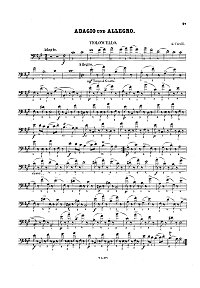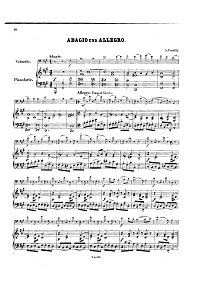Corelli - Adagio and Allegro for cello and piano
Corelli - Adagio and Allegro for cello and piano. You can download the sheet music Corelli - Adagio and Allegro for cello and piano on this page. This excellent musical composition - is a traditional masterpiece composition for cello by the well-known composer. This composition inspires listeners by the charming melody of cello and piano musical language and many other string features. This string opus inspire performer by the clear melody and the harmony of musical text and other string characteristics.
To view the first page of Corelli - Adagio and Allegro for cello and piano click the music sheet image.
|
| PDF format sheet music |
|
|
|
Cello part: 1 pages. 225 K
|
Piano part: 2 pages. 469 K
|
 |
 |
|
|
| Download PDF (14.99
€) |
Download PDF (14.99
€) |
| Arcangelo Corelli (1653 – 1713) was an Italian violinist and composer of the Baroque era. His music was key in the development of the modern genres of sonata and concerto, in establishing the preeminence of the violin, and as the first coalescing of modern tonality and functional harmony.
The style of execution introduced by Corelli and preserved by his pupils, such as Francesco Geminiani, Pietro Locatelli, Pietro Castrucci, Francesco Gasparini, and others, was of vital importance for the development of violin playing. It has been said that the paths of all of the famous violinist-composers of 18th-century Italy led to Arcangelo Corelli, who was their "iconic point of reference".
However, Corelli used only a limited portion of his instrument's capabilities. This may be seen from his writings. The parts for violin very rarely proceed above D on the highest string, sometimes reaching the E in fourth position on the highest string. The story has been told and retold that Corelli refused to play a passage that extended to A in altissimo in the overture to Handel's oratorio The Triumph of Time and Truth (premiered in Rome, 1708), and felt seriously offended when the composer (32 years his junior) played the note.
Nevertheless, his compositions for the instrument mark an epoch in the history of chamber music. His influence was not confined to his own country. Johann Sebastian Bach studied the works of Corelli and based an organ fugue (BWV 579) on Corelli's Opus 3 of 1689. Handel's Opus 6 Concerti Grossi take Corelli's own older Opus 6 Concerti as models, rather than the later three-movement Venetian concerto of Antonio Vivaldi favoured by Bach.
Musical society in Rome also owed much to Corelli. He was received in the highest circles of the aristocracy, and for a long time presided at the celebrated Monday concerts in the palace of Cardinal Ottoboni. Corelli died in Rome in possession of a fortune of 120,000 marks and a valuable collection of works of art and fine violins, the only luxury in which he had indulged. He left both to his benefactor and friend, who generously made over the money to Corelli's relatives. Corelli is buried in the Pantheon at Rome.
His concerti grossi have often been popular in Western culture. For example, a portion of the Christmas Concerto, Op. 6 No. 8, is in the soundtrack of the film Master and Commander: The Far Side of the World, and Corelli's Op. 6 No. 2 also provided the theme for Sir Michael Tippett's Fantasia Concertante on a Theme of Corelli. |
|